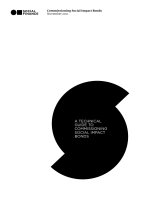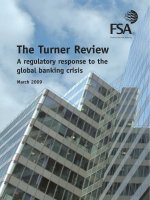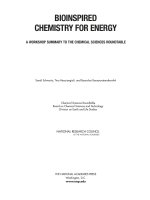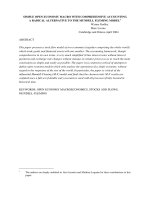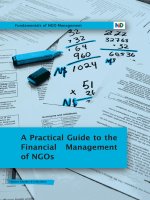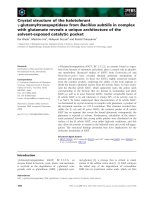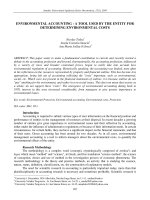SIMPLE OPEN ECONOMY MACRO WITH COMPREHENSIVE ACCOUNTING A RADICAL ALTERNATIVE TO THE MUNDELL FLEMING MODEL ppt
Bạn đang xem bản rút gọn của tài liệu. Xem và tải ngay bản đầy đủ của tài liệu tại đây (491.48 KB, 13 trang )
SIMPLE OPEN ECONOMY MACRO WITH COMPREHENSIVE ACCOUNTING
A RADICAL ALTERNATIVE TO THE MUNDELL FLEMING MODEL
1
Wynne Godley
Marc Lavoie
Cambridge and Ottawa April 2004
ABSTRACT
This paper presents a stock flow model of two economies (together comprising the whole world)
which trade goods and financial assets with one another. The accounting framework, though
comprehensive in its own terms, is very much simplified (it has interest rates without interest
payments and exchange rate changes without changes in relative prices) so as to reach the main
conclusions as simply and easily as possible. The paper is (a contrario) critical of attempts to
deploy open economy models which only analyse the operations of a single economy, without
regard to the responses of the rest of the world. In particular, the paper is critical of the
influential Mundell-Fleming (M-F) model and finds that the characteristic M-F results are
confuted once a full set of double entry accounts is used with all processes firmly located in
historical time.
KEYWORDS: OPEN ECONOMY MACROECONOMICS, STOCKS AND FLOWS,
MUNDELL-FLEMING
1
The authors are deeply indebted to Alex Izurieta and Mathieu Lequain for their contributions to this
paper.
2
INTRODUCTION
Ever since Mundell (1962, 1963) and Fleming (1962), the “Mundell-Fleming” (M-F) model has
been the workhorse of textbooks but it has also been influential in much professional work on
open economy macro-economics. As is well known, the M-F model is an extension of the IS-LM
model so as to make it include a representation of how the exchange rate and the flows of net
exports are determined. It aims to describe the responses of a “small” open economy and the
constraints within which it operates in a world of free capital movements. Characteristic results
are that under a regime of floating exchange rates countries lose the ability to run an independent
fiscal policy, while under fixed rates they lose control over monetary policy.
The M-F model is scanty in that it only describes a single country and contains no representation
of how the rest of the world responds to, and interacts with, what it does. And the logical
framework of M-F is impoverished in that (like the IS-LM model itself), while “the money
supply” plays a key role, money has no accounting relationship to any other variable. The model
also contains no explicit analysis of what happens when either goods and services or financial
assets are traded between countries. Moreover, the M-F model characterises neither the way in
which the relevant equilibria are found, nor any processes which take place sequentially in real
time.
Alternative, far more complete, frameworks have been proposed (e.g., Tobin and De Macedo
(1980) and Branson and Henderson (1985)) which describe worlds in which mutual trading of
assets between two countries take place. But while these were path-breaking studies, neither
described the sequential processes which would bring about a state of equilibrium.
Much more complex, yet parsimonious, models have been proposed by Godley (1999), Godley
and Lavoie (2004) and Taylor (2004), which extended the earlier models by Tobin et al referred
to above. There remains a place however for a very simple statement of this alternative view, and
one which explicitly confronts the M-F conclusions. It is the purpose of this paper to fulfil such a
role. Our main findings are in flat contradiction to those of M-F.
A SIMPLE BUT (NEARLY) COMPREHENSIVE ACCOUNTING FRAMEWORK
The following matrix describes the flow transactions of two simplified economies which
together comprise the whole world. The top part of the matrix represents the standard NIPA
accounts; the bottom part represents the flow of funds accounts. Sources of funds carry a plus
sign, while uses of funds carry a minus sign. The accounting is only nearly comprehensive,
because, to help cut off the number of equations, interest income arising from bills has been
omitted; it is assumed to be of a second order importance in relation to the main conclusions of
this paper.
3
Imports into one country are all the exports from the other and vice versa. Bills issued by each
government may be purchased by the residents of either country. Transactions by all agents in
the $ country are measured in $ currency, while transactions in the # country are measured in #
currency, hence all cross border transactions must be converted from one currency to the other –
in the matrix by multiplying the relevant $ denominated entries in the $ section by the exchange
rate (xr) in the central column. The matrix defines every variable to be used in the model but
these definitions will be repeated in the text. Each country has four sectors, households (HH),
firms (Frm), the Central Bank (CB) and the government (Gvt).
THE MODEL
The national income identity for each country, written as firms’ appropriation account, is shown
in columns 2 and 6
1) 2) Y$ º C$ + G$ + X$ – IM$ Y# º C# + G# + X# – IM#
where Y is GDP, C consumption, G government expenditure X is exports and IM imports.
The government budget restraints, from columns 4 and 8, are
3) 4) -B$ º G$ – T$ -B# º G# – T#
where B$, B# describes total bills which must be issued by the $, # governments to finance their
deficits.
The allocation of bills to their possible purchasers are
5) 6) B$$
s
º B$ – B#$
s
– BCB$
s
– BCB#$
s
B$#
s
º B# – B##s – BCB#
s
The notational principle is that when there are two currency symbols ($ and #), the first denotes
the country in which a bill is sold, the second denotes the country from which the bill originates.
BCB describes bills sold to the central bank by the government of each country while BCB#$
describes bills sold by the $ country to the central bank of the # country; this last variable may be
equated with foreign exchange reserves. The central bank of the $ country is assumed to hold no
foreign exchange reserves. The subscript s denotes supply.
DEFICIT COUNTRY $ SURPLUS COUNTRY #
1.HH$ 2.Frm$
3.CB$ 4.Gvt$
XR
5.HH# 6.Frm# 7.CB# 8.Gvt#
;
1. Consumption -C$ +C$ -C# +C# 0
2. Gov. Expenditure +G$ -G$ +G# -G# 0
3. Exports/Imports +X$ xr -IM# 0
4. Imports/Exports -IM$ xr +X# 0
5. Output/Income +Y$ -Y$ +Y# -Y# 0
6. Taxes -T$ +T$ -T# +T# 0
7.
-
Money -
-
M$ +
-
M$ -
-
M# +
-
M# 0
8. -Bills $ B$$ Bcb$
+-B$ xr B#$ Bcb#$
0
9.
-
Bills # -
-
B$# xr -
-
B## -
-
Bcb# +
-
B# 0
;
0 0 0 0 0
0 0 0
4
Personal disposable income (including capital gains, hence “Haig-Simons” income), YD is
7) 8) YD$ º Y$ – T$+ -xrr.B$#
s-1
YD# ºY# – T# + -xr.B#$
s-1
where T is tax payments, xrr is the exchange rate that transforms the # currency into dollars
(xrr º 1/xr), B$#s is # bills supplied to $ households denominated in # currency and is B#$s is $
bills supplied to # households denominated in $ currency
The central banks’ balance sheets are
9) 10) BCB$
d
º H$
s
-BCB#
d
º -H#
s
– -BCB#$
s.
xr
where H describes the supply of cash to the private sector.
9a) 10a) BCB$
s
= BCB$
d
BCB#
s
= BCB#
d
Clearly the $ country stands for the American economy, since its central bank does not hold any
foreign reserves. Its currency is the international money.
Wealth accumulation by the two private sectors is
11) 12) -V$ º YD$ – C$ -V# º YD# – C#
where V is wealth.
Taxes are determined by the appropriate tax rate, P, and income
13) 14) T$ = P$Y$ T# = P#Y#
Imports are determined by income and price elasticities
15) 16) im$ = T
0$
+ T
1$
y$ – T
2$
xr im# = T
0#
+ T
1#
y# – T
2#
xrr
where bold (lower-case) letters denominate logs.
Exports are
17) 18) X$ = IM#.xrr X# = IM$.xr
The consumption functions are
19) 20) C$ = I
1
YD$ + I
2
V$
-1
C# = I
1
YD# + I
2
V#
-1
The lagged stock variable supplies the essential dynamic component which will generate
sequences in real time.
Note that by virtue of the identities 7) and 8) the consumption functions can alternatively be
written as wealth adjustment functions
19a) 20a) -V$ = I
2
(I
3
YD$ – V$
-1
) -V# = I
2
(I
3
YD# – V#
-1
)
where I
3 =
(1 – I1)/I2
The array of asset demands for $ residents is
5
21) H$
d
/V$ = S
10$
– S
12$
rb$ – S
13$
rb# + S
14$
YD$/V$
22) B$$
d
/V$ = S
20$
+ S
22$
rb$ – S
23$
rb# – S
24$
YD$/V$
23) B$#
d
/V$ = S
30$
– S
32$
rb$ + S
33$
rb# – S
34$
YD$/V$
where all assets are valued in the $ currency and the subscript d denotes demand.
For # residents the array is
24) H#
d
/V# = S
10#
– S
12#
rb$ – S
13#
rb# + S
14#
YD#/V#
25) B#$
d
/V# = S
20#
+ S
22#
rb$ – S
23#
rb# – S
24#
YD#/V#
26) B##
d
/V# = S
30#
– S
32#
rb$ + S
33#
rb# – S
34#
YD#/V#
where all assets are valued in # currency.
It follows from equations 21) to 26) that residents of each country hold cash denominated in their
own currency only; but they hold securities issued in either country.
All parameters in these arrays are constrained according to Tobinesque principles so that the sum
of constants is equal to one and the sum of each of the other columns is zero. As 21) and 24) are
in each case logically implied by the two following equations, the demand for cash must be
entered into the simulation model (as Tobin laid down) as follows to avoid over-determination.
21a) 24a) H$
d
º V$ – B$$
d
– B$#
d
H#
d
º V# – B##
d
– B#$
d
A FLEXIBLE EXCHANGE REGIME CLOSURE
All the excitement turns on how the model is now closed, that is how asset demands and supplies
are brought into equivalence. We shall first consider the case of freely floating exchange rates,
which implies that there are no dealings in reserves, i.e., BCB#$ is treated as exogenous and
fixed.
The central banks have no option but to supply the cash demanded by residents of their own
country – that is, to exchange them freely for bills given that they have set a (fixed) bill rate
exogenously.
27) 28) H$
s
= H$
d
H#
s
= H#
d
There is no way in which, at given interest rates, the central bank can dump cash (“increase the
money supply”) beyond what residents wish to hold given those interest rates.
It now becomes impossible to write all the remaining supplies as determined by demands.
We can write
29) 30)
B##
s
= B##
d
and
B#$
s
= B#$
d.
xrr
but we cannot write
6
31a) B$#s = B$#d/xrr
because we already have, in 6), an equation in B$#s and, in 23), an equation in B$#d.
And we cannot write
31b) B$$s = B$$d
as both these terms have also been determined already, in 5) and 22).
Yet because every row and every column in the matrix sum to zero, there must always be one
equivalence which must be “dropped” if the model is to be capable of solution. In this particular
case the coherence of the accounting system as a whole will ensure that 31b) is satisfied – there
is neither need nor place for it in the formal model (this is the redundant equation).
There is now only one way to close this particular model – to invert 31a) and make it an equation
in which an endogenous exchange rate brings asset demands into equivalence with asset
supplies.
31) xrr = B$#d/B$#s
while remembering that we defined
32) xr = 1/xrr
The model is now complete. Besides the stock of foreign reserves, BCB#$, held by the # central
bank, the exogenous variables are G, P, and r (for each country). Output in each country together
with consumption, imports, exports, wealth and its allocation between the available assets and
the exchange rate are all endogenously determined. When the exchange rate changes, this
changes the import propensity, disposable income and thence output in each country - and thence
in turn the budget deficit/surplus and changed supplies of assets, thence back to the exchange
rate etc.etc. The imaginary economies evolve sequentially through time on their way towards a
full steady state.
The main properties of the model solutions are revealed in the following charts. There is a
particular interest in confronting the major M-F results. First is fiscal policy ineffective? We first
assume, starting from a full stationary steady state, that there is an exogenous step up in
government expenditure in the # country. The immediate consequence is a rise in # output, a rise
in the # budget deficit (implying a rise in the supply of # bills) and a deterioration in the #
balance of trade. This causes a fall in the # currency relative to the “dollar” because of the
relatively large increase in the supply of # bills. The devaluation causes a fall in the # import
propensity which continues until all changes in stock and flow variables cease and the balance of
trade reverts to zero. Output in the # country has been permanently raised. Fiscal policy and also
monetary policy in the form of interest rates are both fully under the control of each government.
The stock of money is not a policy instrument; it is endogenously determined in 27) and 28).
What is exogenous is the rate of interest administered by the central bank.
7
8
9
The inwardness of Chart 3 is made more intuitive if we reformulate the experiment to describe
how a change in one of the interest rates impacts the system under a floating exchange regime.
The rise in the $ rate of interest immediately raises the $ rate of exchange. This disturbs the
whole system by generating fiscal and trade imbalances. The changing exchange rate eventually
restores a steady state. As Chart 4 shows, and as is clearly implied by equations 25) and 26), the
share of $ bills in # portfolios immediately rises and that of # bills in # portfolios falls by an
equivalent amount so long as both shares are measured in # currency. However this conceals the
fact that because the exchange rate has changed the share of $ bills measured in $ currency does
not immediately rise.
10
A FIXED EXCHANGE REGIME CLOSURE
The model can easily be adapted to describe a fixed exchange rate world. First, of course, we
must delete equation 31) and make the exchange rate exogenous and constant; this means that
given any given configuration of interest rates, the government must be willing to buy or sell
bills on any scale whatever at the chosen exchange rate. That is, among the other demand-
determined asset supply functions, we must now have:
31b) B$#s = B$#d /xrr
But the inclusion of this particular equation would over-determine the model. There are now
three alternative possibilities if we imagine this system out of kilter. Either fiscal policy of the
deficit country must adjust to neutralise an ex ante excess supply of bills flowing into the market
(in which case government expenditure or the tax rate must be endogenised); or the (now
endogenous) interest rate in the deficit country must rise indefinitely so that (in theory) a
continuing increase in the relative supply of bills by the deficit country is always willingly held.
The remaining possibility is that the central bank of the surplus country acquires (while the
deficit country disposes of) reserve assets on a limitless scale.
We proceed to explore the last of these three possibilities, noting in advance that under this
assumption both governments still retain full control over both fiscal and monetary policy.
11
All we have to do is invert 5). Instead of
5) B$#
s
= B# – B##s – BCB#
s
we write
5b) BCB#
s
= B# – B##s – B$#
s
The case we want to illustrate is where a surplus country (frankly call it “Japan”) wishes to
maintain its surplus and in so doing purchases reserve assets (US Treasury bills) on whatever
scale is necessary to keep the exchange rate where it is.
The model says that there is no limit to this process. Both economies reach a quasi-stationary
state in which all stocks and all flows including the stock of money do not change at all – but
there is a never ending purchase of Treasury Bills (and a growing stock of Japanese holdings of
US Treasury Bills) without the undesirable effects (an “increase in the money supply”)
postulated in the M-F story.
12
CONCLUSION
We have presented a small 32-equation model, each country being described by only 16
equations, which we believe can adequately represent the behaviour of a whole world
comprising two regions, in a dollar exchange regime. This model can be considered as a
simplified version of the more explicit 90-equation model of Godley and Lavoie (2004) as the
present model replicates the relevant results obtained with the more complex model.
Our model tracks the 2-country dynamics of imports, exports, GDP, disposable income,
consumption, money, bills, wealth and portfolio choices, as well as the exchange rate in the
flexible exchange rate closure, and the amount of foreign reserves in the fixed exchange rate
closure. It has also been shown how easily one can move from one regime to the other.
Simulations with the model clearly show that the main conclusions of the M-F model, that under
a regime of floating exchange rates countries lose the ability to run an independent fiscal policy
while under fixed rates they lose control over monetary policy, are proved to be mistaken. In
particular, under fixed exchange rates, there are no binding constraints to prevent the surplus
economy from running up foreign reserves while the American economy runs balance-of-
payments deficits. The rules of the game of the price-specie flow mechanism, as reincarnated in
the M-F model, just do not apply in a properly constructed 2-country stock-flow model. External
deficits or surpluses do not generate any change in the money supply, which remains entirely
demand-determined, as the economists of the Banque de France used to argue through the
compensation thesis (Berger 1972).
2
2
It must be pointed out that Mundell (1961) himself was aware that the automaticity of the rules of the
game relied on a particular behaviour of the central bank. Indeed he lamented over the fact that
modern central banks were following the banking principle instead of the bullionist principle, and
hence adjusting ‘the domestic supply of notes to accord with the needs of trade’ (1961, p. 153).
13
REFERENCES
Berger, P. (1972), ‘Rapports entre l’évolution de la balance des paiements et l’évolution de la
liquidité interne’, in A. de Lattre and P. Berger (eds), Monnaie et balance des paiements, Paris:
Armand Colin, pp. 89-110.
Branson, W.H and Henderson, D.W. (1985), ‘The specification and influence of asset markets’,
in R. Jones and P.B. Kenen (eds), Handbook of International Economics, vol. 2, Amsterdam,
North-Holland, pp. 749-805.
Fleming, J.M. (1962), ‘Domestic financial policies under fixed and under floating exchange
rates’, International Monetary Fund Staff Papers, 9 (Nov.), 369-379.
Godley, W. (1999), ‘Open economy macroeconomics using models of closed systems’, The
Jerome Levy Economics Institute, WP 281.
Godley, W. and Lavoie, M. (2004), ‘Two-country stock-flow consistent macroeconomics using a
closed model within a dollar exchange regime’, CERF working paper, University of Cambridge.
Mundell, R. (1961), ‘The international disequilibrium system’, Kyklos, 14 (2), 153-172.
Mundell, R. (1962), ‘The appropriate use of monetary and fiscal policy for internal and external
stability’, International Monetary Fund Staff Papers, 9 (March), 70-77.
Mundell, R. (1963), ‘Capital mobility and stabilization policy under fixed and flexible exchange
rates’, Canadian Journal of Economics and Political Science, 29 (Nov.), 475-485.
Taylor, L. (2004), ‘Exchange indeterminacy in portfolio balance, Mundell-Fleming, and
uncovered interest rate parity models’, Cambridge Journal of Economics, 28 (2), 205-228.
Tobin, J. and De Macedo, J. B. (1980), ‘The short-run macroeconomics of floating exchange
rates: An exposition’, in J. Chipman and C. Kindleberger (eds), Flexible Exchange Rates and the
Balance of Payments: Essays in the Memory of Egon Sohmen, Amsterdam, North Holland,
Amsterdam, pp. 5-28.
